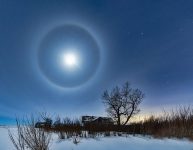Old habits
5 min read
Media awareness about global warming and climate change has grown fairly steadily since 2004. My impression is that journalists today tend to possess a higher climate literacy than before. This increasing awareness and improved knowledge is encouraging, but there are also some common interpretations which could be more nuanced. Here are two examples, polar amplification and extreme rainfall.
Polar amplification
A recent report on the ice on Greenland in the Washington Post discussed the melting of land-based ice on Greenland. The melting of ice in the polar regions is a great concern and is exacerbated by the so-called Polar Amplification which is responsible for a rapid warming in the polar region, especially in the Arctic.
In the said report, the fast pace of melting was explained as a consequence of a spiraling effect, where retreating ice uncovers a darker surface that soaks up more heat from the sunlight (the so-called albedo-feedback):
Vanishing land ice — such as ice sheets and glaciers — can also create a feedback loop. But because land isn’t quite as dark as the surface of the ocean, it doesn’t cause as much additional heating. This is partly why the South Pole (which is covered by the Antarctic continent) isn’t warming as fast as the North Pole (which is surrounded by ocean).
The situation is more complicated, however, as the strongest Arctic warming takes place in winter during polar nights, when the days are subject to 24-hr darkness. In other words, there is no albedo effect that can explain this exceptional warming because of the lack of sunlight.
Yet, sea-ice acts as an insulator between air and sea. When it retreats, it opens up for more heat and moisture exchange between the ocean and the atmosphere, and the strongest warming can be found where the sea-ice has retreated (Isaksen, et al., 2022).
There are also additional mechanisms that can explain the rapid warming near the poles. One of them is that the already colder conditions are responsible for lower heat losses, but this is the case for Antarctica as well.
Changes in cloud cover and air moisture (vapour pressure) also play a role. If there is a permanent cloud cover, then we expect a reduced albedo-feedback connected with ice and snow. Clouds also affect the albedo, and both clouds and air moisture affect the surface heat loss to space.
Other mechanisms include changes in the lapse rate (Boeke et al., 2020) and boundary layers (Bintanja et al., 2012), as well as heat transport from lower latitudes.
Storms may also influence the temperature indirectly through their effect on sea-ice. A take-home message from a talk by Gabriele Messori, Ehlke Hepworth, and Marcello Vichi at the European Meteorological Society’s 2023 annual meeting in Bratislava was that high-latitude cyclones in the Southern Ocean can reach and shape the Antarctic sea-ice.
Storms also play a role in the Arctic, and Aue and Rinke (2023) reported that seasonal variations in storms leave an imprint on the sea ice concentration in the Barents and Kara Seas. They also found that storms have an impact on the Arctic sea ice and that it has changed during the last 40 years.
Finally, in the BAMS State of the Climate (2023) the Arctic amplification was also associated with various localised land–ocean–sea-ice interactions as well as large-scale atmospheric and oceanic energy transport processes.
Extreme rainfall
Another common topic is extreme rainfall, and the link to global warming is often explained in terms of increased evaporation with higher temperatures. This is not wrong, but also not the whole story.
We can call it the thermodynamical explanation, and we indeed expect more extreme rainfall with higher temperatures which enhance the air’s moisture holding capacity and increase the rate of evaporation.
There are also dynamical aspects, which involve changes in winds and cloud structure, but they are rarely mentioned in news reports.
The water that evaporates comes down again, but in patches. It doesn’t rain all the time nor everywhere. Over time, the daily rain has fallen over a shrinking fraction of Earth’s surface (Benestad et al., 2022), thus becoming more concentrated into smaller and more intense wet patches.
A recent and tentative (not yet peer-reviewed) analysis suggests that about half of the increased extreme precipitation may be due to thermodynamics and about half may be due to dynamics (Benestad et al., 2023)
The dynamical nature of this trend may involve more convective clouds, higher cloud tops or an expansion of the sub-tropics connected to a widening of the Hadley cell. Another factor may be a slowdown of moving rain-generating systems (Kahraman et al, 2023).
There are reports of increased rainfall amounts connected with tropical cyclones, which combines both thermodynamics (evaporation) and dynamics (wind and cloud structures). Recently storm Daniel brought extreme rainfall amounts that caused devastating calamities both in Greece/Bulgaria/Turkey as well as Libya. The extreme rainfall was a result of both excessive evaporation (the Mediterranean Sea has been unusually warm) and circulation.
References
K. Isaksen, �. Nordli, B. Ivanov, M.A.�. Køltzow, S. Aaboe, H.M. Gjelten, A. Mezghani, S. Eastwood, E. Førland, R.E. Benestad, I. Hanssen-Bauer, R. Brækkan, P. Sviashchennikov, V. Demin, A. Revina, and T. Karandasheva, “Exceptional warming over the Barents area”, Scientific Reports, vol. 12, 2022. http://dx.doi.org/10.1038/s41598-022-13568-5
R.C. Boeke, P.C. Taylor, and S.A. Sejas, “On the Nature of the Arctic’s Positive Lapse‐Rate Feedback”, Geophysical Research Letters, vol. 48, 2021. http://dx.doi.org/10.1029/2020GL091109
R. Bintanja, E.C. van der Linden, and W. Hazeleger, “Boundary layer stability and Arctic climate change: a feedback study using EC-Earth”, Climate Dynamics, vol. 39, pp. 2659-2673, 2011. http://dx.doi.org/10.1007/s00382-011-1272-1
L. Aue, and A. Rinke, “Cyclone Impacts on Sea Ice Concentration in the Atlantic Arctic Ocean: Annual Cycle and Recent Changes”, Geophysical Research Letters, vol. 50, 2023. http://dx.doi.org/10.1029/2023GL104657
J. Blunden, T. Boyer, and E. Bartow-Gillies, “State of the Climate in 2022”, Bulletin of the American Meteorological Society, vol. 104, pp. S1-S516, 2023. http://dx.doi.org/10.1175/2023BAMSStateoftheClimate.1
R.E. Benestad, C. Lussana, J. Lutz, A. Dobler, O. Landgren, J.E. Haugen, A. Mezghani, B. Casati, and K.M. Parding, “Global hydro-climatological indicators and changes in the global hydrological cycle and rainfall patterns”, PLOS Climate, vol. 1, pp. e0000029, 2022. http://dx.doi.org/10.1371/journal.pclm.0000029
R.E. Benestad, C. Lussana, and A. Dobler, “Global surface area receiving daily precipitation, wet-day frequency and probability of extreme rainfall: Water Security and Climate Change”, 2023. http://dx.doi.org/10.21203/rs.3.rs-3198800/v1
A. Kahraman, E.J. Kendon, S.C. Chan, and H.J. Fowler, “Quasi‐Stationary Intense Rainstorms Spread Across Europe Under Climate Change”, Geophysical Research Letters, vol. 48, 2021. http://dx.doi.org/10.1029/2020GL092361
The post Old habits first appeared on RealClimate.



